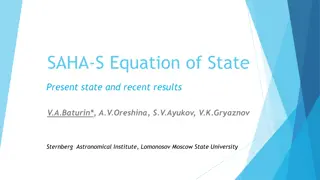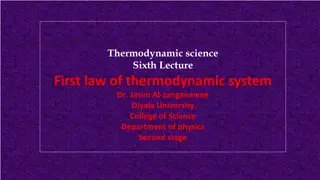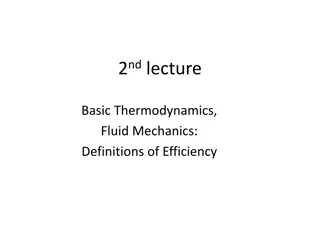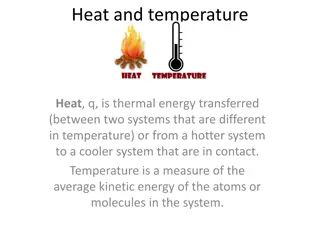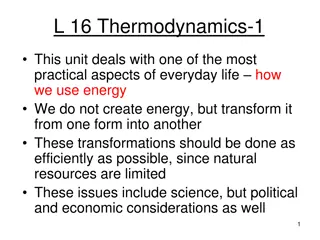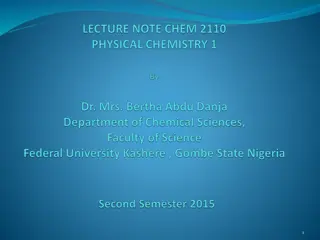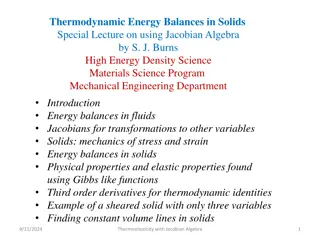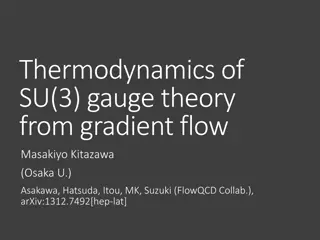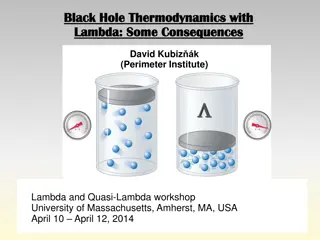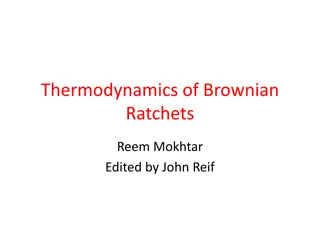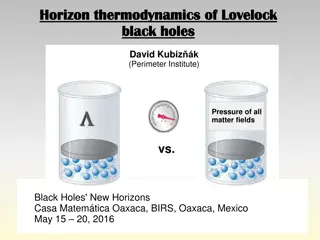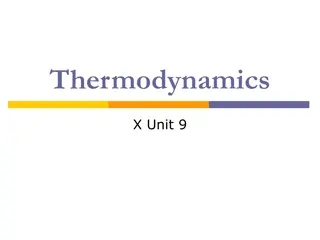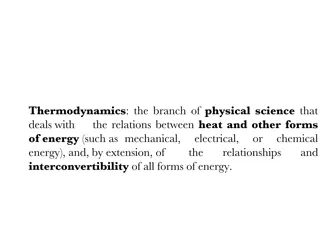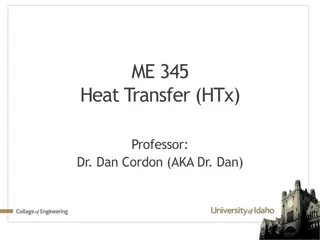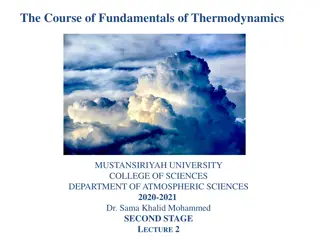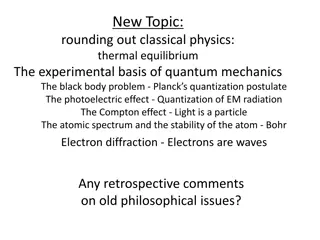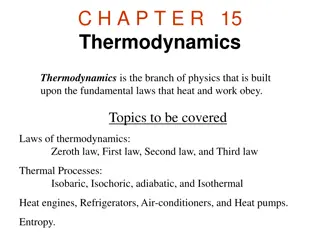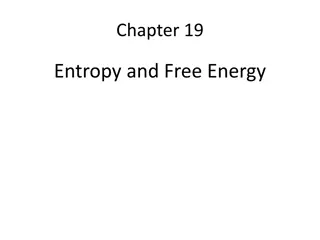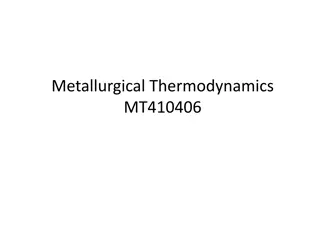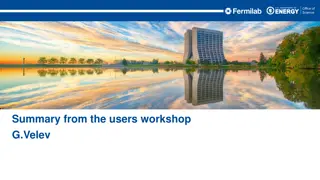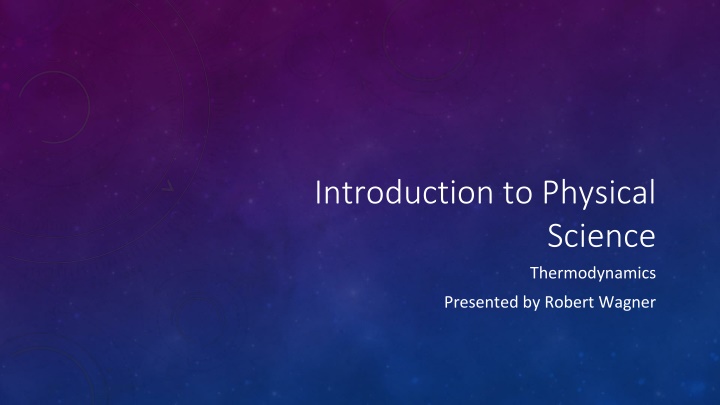
Introduction to Thermodynamics in Physical Science
Delve into the fundamental concepts of thermodynamics, focusing on the First Law and its application to systems undergoing heat transfer and work. Explore the principles of energy conservation and the net change in internal energy. Through examples and illustrations, grasp the workings of heat engines and the varying paths impacting work output. Engage with calculations of total work done within cyclical processes, enhancing your comprehension of energy transformations in systems.
Uploaded on | 5 Views
Download Presentation

Please find below an Image/Link to download the presentation.
The content on the website is provided AS IS for your information and personal use only. It may not be sold, licensed, or shared on other websites without obtaining consent from the author. If you encounter any issues during the download, it is possible that the publisher has removed the file from their server.
You are allowed to download the files provided on this website for personal or commercial use, subject to the condition that they are used lawfully. All files are the property of their respective owners.
The content on the website is provided AS IS for your information and personal use only. It may not be sold, licensed, or shared on other websites without obtaining consent from the author.
E N D
Presentation Transcript
Introduction to Physical Science Thermodynamics Presented by Robert Wagner
First Law of Thermodynamics Change in internal energy of a system is equal to the net heat transfer into the system minus the net work done by the system ? = ? ? Conservation of energy for a system in thermal equilibrium Image Credit: OpenStax College Physics - Figure 15.3 CC BY 4.0
Example There is a heat transfer of 40.00 J to a system, while the system does 10.0 J of work. Later, there is heat transfer of 25.00 J out of the system while 4.00 J of work is done on the system. What is the net change in internal energy of the system? Draw a sketch (if applicable) Identify known values Identify equation Enter values in the equation and solve Image Credit: OpenStax College Physics - Figure 15.4a CC BY 4.0
Example There is a heat transfer of 40.00 J to a system, while the system does 10.0 J of work. Later, there is heat transfer of 25.00 J out of the system while 4.00 J of work is done on the system. What is the net change in internal energy of the system? ?1= 40.00?;?2= 25.00? ?1= 10.00?;?2= 4.00? ????= ?1+ ?2 ????= ?1+ ?2 ? = 40.00? 25.00? = 15.00? ? = 10.00? 4.00? = 6.00? Draw a sketch (if applicable) Identify known values ? = ? ? = 15.00? 6.00? Identify equation ? = 9.00? Enter values in the equation and solve Image Credit: OpenStax College Physics - Figure 15.4a CC BY 4.0
Heat Engine A device that uses heat energy to do work Car engine Steam turbines Work done depends on the path taken PV diagram Vertical paths - constant volume - isochoric Horizontal paths - constant pressure - isobaric. ? = ? ? Image Credit: OpenStax College Physics - Figure 15.7 CC BY 4.0
Heat Engine A device that uses heat energy to do work Car engine Steam turbines Work done depends on the path taken PV diagram Vertical paths - constant volume - isochoric Horizontal paths - constant pressure - isobaric. ? = ? ? Image Credit: OpenStax College Physics - Figure 15.10 CC BY 4.0
Example Calculate the total work done in the cyclical path ABCDA shown here. Calculate the work done along each segment to get the total work. Draw a sketch (if applicable) Identify known values Identify equation Enter values in the equation and solve Image Credit: OpenStax College Physics - Figure 15.12b CC BY 4.0
Example ???= 1.50?106?/?2;??? = 2.00?105?/?2 Calculate the total work done in the cyclical path ABCDA shown here. Calculate the work done along each segment to get the total work. ? = 500.??3= 5.00?10 4?3 ???= ??? ??? ???= (1.50?106?/?2)(5.00?10 4?3) = 750.? Draw a sketch (if applicable) Identify known values ???= ??? ???= 0 Identify equation ???= ??? ??? ???= (2.00?106?/?2)( 5.00?10 4?3) = 100.? Enter values in the equation and solve ???= ??? ???= 0 Image Credit: OpenStax College Physics - Figure 15.12b CC BY 4.0
Reversible Processes Reversible process - the system and environment can return to their original states by following the reverse path When dissipative processes like friction or turbulence exist, a process cannot be reversible
Second Law of Thermodynamics Many process occur spontaneously in one direction only They are irreversible processes Heat will never transfer spontaneously from a cool object to a hot one Mechanical energy can be completely converted to thermal energy, but the reverse cannot occur Air will spread through a container, but not group in a corner Image Credit: OpenStax College Physics - Figure 15.16 CC BY 4.0
Second Law of Thermodynamics (2) 1st Expression Heat transfer occurs spontaneously from higher to lower temperature bodies, but never spontaneously in the reverse direction. Heat Engines Want high efficiency ? = ? ;??= 0 2nd expression It is impossible for any system for heat transfer from a reservoir to completely convert work in a cyclical process in which the system returns to its original state. Image Credit: OpenStax College Physics - Figure 15.17 CC BY 4.0
Cyclical Processes A cyclical process brings a system back to its original state at the end of each cycle. ????= ? ?? Conversion efficiency: ratio of what we get to what is input ? ? =? ?? = 1 ?? ??? = ? ? Efficiency can never be 1. Some energy is always lost Image Credit: OpenStax College Physics - Figure 15.17 CC BY 4.0
Example A coal power plant uses heat transfer from burning coal to turn turbines which generate electricity. Suppose in a single day, the station has 2.50x1014 J heat transfer from coal and 1.48x1014 J heat transfer into the environment. What is the work done by the power station? What is the efficiency of the power station? Draw a sketch (if applicable) Identify known values Identify equation Enter values in the equation and solve Image Credit: OpenStax College Physics - Figure 15.17 CC BY 4.0
Example A coal power plant uses heat transfer from burning coal to turn turbines which generate electricity. Suppose in a single day, the station has 2.50x1014 J heat transfer from coal and 1.48x1014 J heat transfer into the environment. What is the work done by the power station? What is the efficiency of the power station? Draw a sketch (if applicable) Identify known values Identify equation Enter values in the equation and solve ? = 2.50?1014?;??= 1.48?1014? ? = ? ?? ? = 2.50?1014? 1.48?1014? = 1.02?1014? ??? =? ? ??? =1.02?1014? 2.50?1014?= 0.408 = 40.8% Image Credit: OpenStax College Physics - Figure 15.17 CC BY 4.0
Summary 1st Law: Law of conservation of energy. Change in energy = energy in less the energy out Heat engines are devices that we use to do work on a system 2nd Law: A system can never convert heat to work with 100% efficiency

